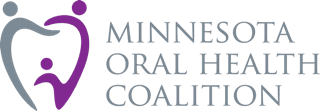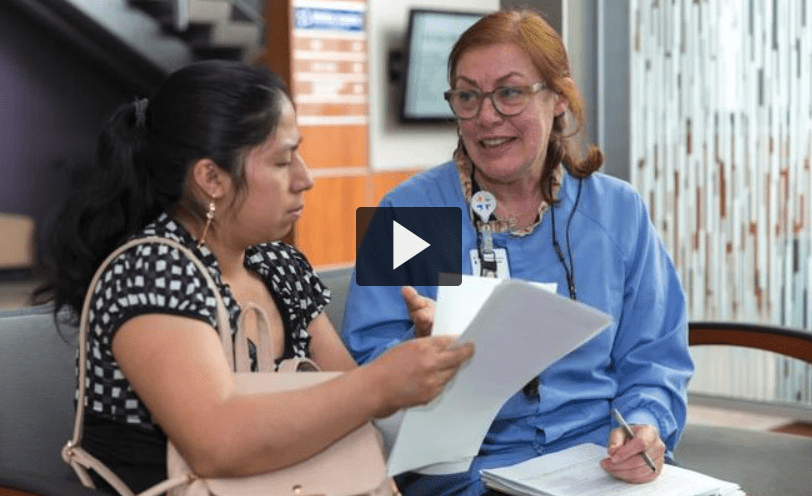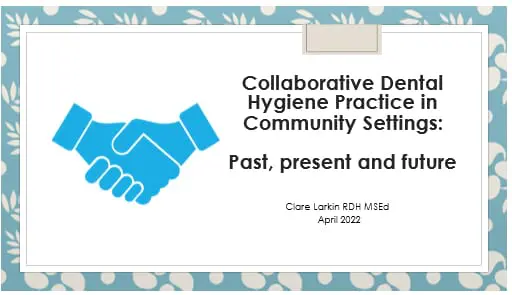WELCOME
COLLABORATIVE DENTAL HYGIENE PRACTICE TOOLKIT
OFFERING GUIDANCE AND SUPPORT
FOR
MINNESOTA’S 21ST CENTURY DENTAL TEAM
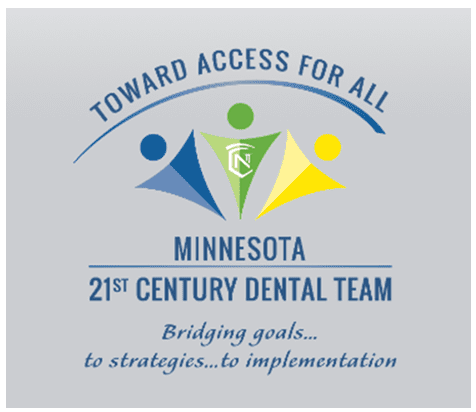
Logo designed by Normandale Community College; image used with permission
Advancing the role of the dental hygienist to expand the reach of oral health care to vulnerable, underserved, and rural populations.
This website has been made possible through financial support and guidance from the following:
- Health Resources and Services Administration (HRSA) of the US Department of Health and Human services grant funding for the Normandale Community College “Innovative Pathways to Advanced Practice for Dental Hygienists: Meeting the Needs of Minnesota's Underserved Population. (2015)
- Delta Dental of Minnesota Foundation
- Minnesota Community Foundation
- 3M Foundation funding for Minnesota Oral Health Coalition website enhancement
NOTE: Materials in this website refer frequently to the Normandale Community College (NCC) "Minnesota 21st Century Dental Team/Collaborative Dental Hygiene Practice (CDHP) Toolkit." Please note that as of 2023, the robust NCC toolkit is no longer available; Many of the resources and materials from the original website have been moved to this Minnesota Oral Health Coalition CDHP Toolkit site. Contact the Minnesota Oral Health Coalition (MOHC) if you are seeking a specific item.
Minnesota 21st Century Dental Team Video (3:00)
View HERE
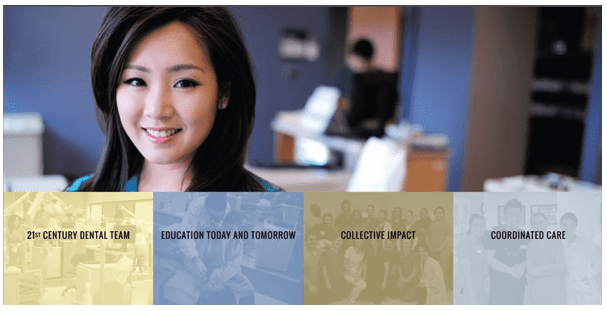
Collaborative Dental Hygiene Practice: What is it?
Everyone deserves to have a “dental home.” A “dental home” need not be a four walls/bricks and mortar building.
Collaborative dental hygiene practice (CDHP) in community settings (Minnesota Statutes 150A.10, Subd. 1a) authorizes Minnesota licensed dental hygienists to practice within a community-focused model resulting in more people with access to preventive services and in finding a dental home. Dental hygienists can effectively provide "coordinated care" to under-resourced populations in non-traditional health care settings.
- The CDHP workforce model was authorized by the Minnesota Legislature in 2001.
- Services may be performed by the dental hygienist without the presence of a dentist and without a prior exam of the patient by a dentist.
The initiative was supported with grant funds from Delta Dental of Minnesota Foundation; Minnesota Department of Health; Minnesota Community Foundation. Normandale Community College paved the way following introduction of Collaborative Dental Hygiene Practice (CDHP) in Community Settings (2001).
Signing on as a Collaborative Practice Dentist: Tangible and Intangible Benefits
In addition to increasing access to dental care, entering into a collaborative agreement provides an opportunity to innovate with other dental professionals to create a more sustainable dental delivery system. With collaborative dental hygiene practice models, dental professionals can meet patients where they're at - whether it's in a school, a nursing home, a memory care facility, hospital, etc. As a result, more people will get the care they need. CDHP allows a dentist and dental team to provide services to the community and extend the reach of their work. The tangible benefits to entering into a collaborative agreement will vary depending on organizational structure but could include increased revenue for the dental practice if it is structured that way. The intangible benefits may include increased job satisfaction, brand awareness, and customer/patient loyalty. Dental practices that engage in CDHP with their existing staff could also see intangible benefits in increased employee morale and retention. Utilizing collaborative practice provides a unique opportunity for dental teams to come together with a common purpose and passion to create innovative paths inside dentistry.
Forging Change as a Collaborative Practice Dental Hygienist Eva Romero, Whittier Clinic and Hennepin Healthcare
View HERE
Minnesota Statutes (Laws), Rules and Regulations
2022 Minnesota Statutes
150A.10 ALLIED DENTAL PERSONNEL.
Minnesota Statutes 150A.10, subd. 1a (law) that authorizes Collaborative Dental Hygiene Practice in Community Settings and describes the community settings in which collaborative practice dental hygienists may provide care.
View HERE
Minnesota Administrative Rules
CHAPTER 3100, DENTISTS, HYGIENISTS, AND ASSISTANTS
Minnesota Administrative Rules 3100.8700 lists/describes dental hygiene scope of practice/procedures that may be provided by a collaborative practice dental hygienist under general supervision and as outlined in a written collaborative agreement.
Note: Chapter 3100 is a lengthy document. Click the link to download and access Section 3100.8700 pertaining
to dental hygienists.
View HERE
A Positive Outcome Through Collective Impact


Key Points Concerning Collaborative Dental Hygiene Practice/Collaborative Agreements
- Collaborative Dental Hygiene Practice (CDHP) was introduced for community-based, not traditional, dental/dental hygiene practice.
- It is not appropriate, nor necessary, to develop or register a written collaborative agreement in a traditional dental practice setting for staff to expose radiographs or to “see a new patient first”. In doing so, data become skewed regarding community impact of this innovative workforce model.
- Minnesota does not require additional education or a designated credential, e.g., CPDH, to be employed or engaged in Collaborative Dental Hygiene Practice (CDHP).
- Although the presence of a dentist or a prior exam of the patient by a dentist is not required, Minnesota Statutes 150A.10, Subd. 1a does not authorize independent dental hygiene practice.
View CDHP PowerPoint HERE
Creating Your Collaborative Agreement “How-To” Tutorial (Voice-over PowerPoint; 17 minutes)
Deborah Jacobi, RDH MA
View HERE
NOTE: this video makes reference to the Normandale Community College Collaborative Dental Hygiene Practice (CDHP) Toolkit. Please note that as of 2023, the original toolkit is no longer available; Resources and materials have been moved to this Minnesota Oral Health Coalition CDHP Toolkit site.
View Word Doc HERE
View PDF Doc HERE
NOTE:
- The template contains sections that are required per Minnesota Statutes and sections that are recommended as “best practices”.
- The template was reviewed by the Minnesota Board of Dentistry, Minnesota Dental Hygienists'
Association and Minnesota Dental Association.
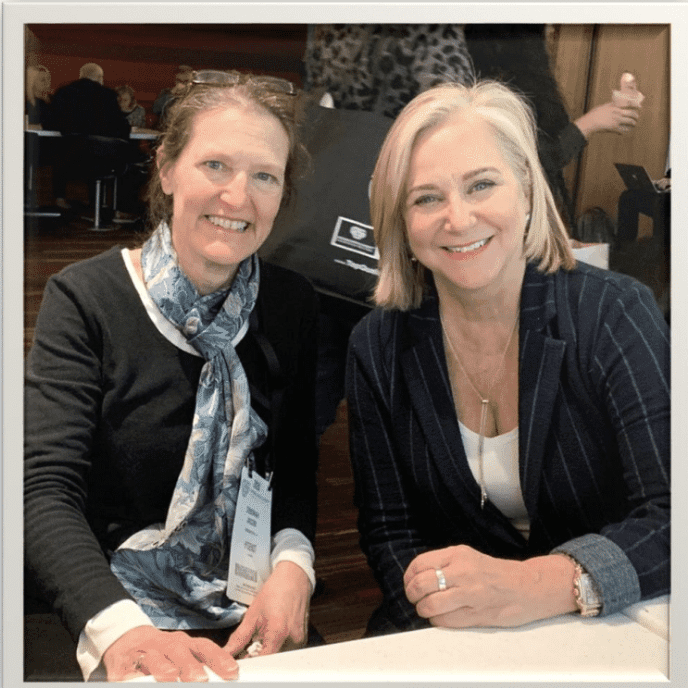
How to Register a Collaborative Agreement with the Minnesota Board of Dentistry
View HERE

COLLABORATIVE DENTAL HYGIENE PRACTICE “COFFEE TALKS” VIDEOS
(Five videos; 50 minutes total).
Continuing Dental Education (CE):
The Minnesota Board of Dentistry has approved two fundamental credits for participation in the Coffee Talk series. To obtain (no-cost) CE credit:
- Print out the objectives/presenter biographies page
- Print out and answer the questions related to each video (45 -60 minutes, total). An answer key is provided with each set of questions.
- A printout of the objectives and completed questions will serve as documentation for your professional portfolio.
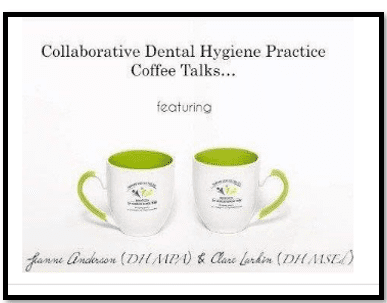
Closed Captioning (CC) is available within each video.
Coffee Talk Objectives/Presenter Biographies for CE Credit
Download HERE

Photo used with permission; Normandale Community College
L to R: Jeanne Anderson, Debra Sidd, Clare Larkin
Coffee Talk 1: State of the Union (8:24)
View HERE
Coffee Talk 1 - Post test Download HERE
Coffee Talk 2: Unraveling the Mysteries - Part I (9:37)
View HERE
Coffee Talk 2 - Post test Download HERE
Coffee Talk 3: Unraveling the Mysteries - Part II (11:14)
View HERE
Coffee Talk 3 - Post test Download HERE
Assessing the State of Collaborative Dental Hygiene Practice in Minnesota.
Report of the Survey of Licensed Dental Hygienists. July 2020
The report was supported by the Health Resources and Services Administration (HRSA) of the U.S. Department of Health and Human Services (HHS) as part of an award to Normandale Community College.
Particularly helpful to new dental hygiene graduates/faculty/staff and licensed dental hygienists/ dentists who are considering this collaborative model of care!
This report is a detailed evaluation plan based on a study originally done in 2003 regarding collaborative dental hygiene practice—just two years after enactment of the law authorizing dental hygiene practice in non-traditional dental settings. The report also details the findings from a statewide survey of licensed dental hygienists in 2019. Read this report to better understand how collaborative dental hygiene practice (CDHP) is being utilized in Minnesota and what dental hygienists in the field had to say sixteen years after the original survey.

Licensed dental hygienists participating in
Minnesota's first
"Basic Screening Survey Calibration Training"
__________________
Creating a Dentist-Dental Hygienist Collaborative Relationship
Interview with Holly Jorgenson, RDH
Let's Smile, Inc. Owatonna MN
April 16, 2020
Tell me about the Let's Smile story, and how you found your collaborative dentist.
I was a sub at a dental practice in my hometown, covering for a hygienist who was on medical leave. Being in that position provided a wonderful opportunity to develop a professional relationship with the dentist owner. I noticed that he participates in Give Kids a Smile (GKAS) and sponsors local children’s park and rec teams. In 2013, I approached him with the idea of becoming a collaborative dentist for me. I explained my plan to provide dental hygiene services to low income children and adolescents through nontraditional practice based in school-based clinics.
He was hesitant at first since he had not heard of this concept. I provided him with information found on the Normandale Community College “21st Century Dental Team” website regarding Collaborative Dental Hygiene Practice in Community Settings. These are fantastic resources!
The dentist was under the impression that he would have to take all the referrals of the children seen by Let’s Smile. He was a current provider for Delta Dental Civic Smiles, Medicaid/Medical Assistance (MA) and UCare, however, the number of patients in his office on MA is limited and only to existing patients.
I found three local offices that would accept Let’s Smile’s MA patients and assured him that I would only use his office as a referral source for GKAS.
What were some of the more difficult things you had to figure out when first practicing as a Collaborative Practice Dental Hygienist?
One thing we worked on was how referrals would work, because the dental practice couldn't handle all of them. To solve for this, I needed to find offices that I could refer to.
How did you accomplish that?
I called around and found other dental offices in the area that would accept MA and referrals. I send most of my referrals to a dental office in a neighboring city. We have a really special relationship and model that makes it a win-win-win for everybody!
Let’s Smile contracts with one of their collaborative hygienists for each school-based dental clinic day. Then, we refer the patients to that dental practice (as well as 2 other locations) for follow up care. Dental therapists in the dental practice see the kids for follow up care when needed. This makes for continuation of care and an ongoing relationship to a dental home. This model is how we make our program sustainable.
You mentioned you have had two collaborative dentists, right?
Yes, after three years my collaborative dentist had some growing concerns over liability issues and chose to no longer participate as Let’s Smile’s collaborative dentist. I then researched dentists that were active in my community. I became aware of another dentist who also participates in GKAS and sponsors local sports teams. He was and still is on the board of the Children’s Remedial Fund. He was and still is an active member of the Minnesota Dental Association. When I approached asked him to be my collaborative dentist, he already had knowledge of how a collaborative agreement works. He very graciously said yes! He wanted to use this model to reach and impact underserved families. He is a current provider for MA and had limited his practice to patients of record. I reassured him that Let’s Smile had a strong referral arrangement already with a dental practice which helped with his decision to participate. He attends the Let’s Smile board meetings, offers me advice, and is a true advocate for oral health care.
Do you have any other tips for hygienists looking to partner with a dentist in a collaborative agreement?
Begin by researching the dentists in your area. How involved are they in the community? What are they doing for the kids (or the populations that you serve)? Do they volunteer? Look for dentists that want to make a difference, and brainstorm together about how it can be done.
What would you say to dental hygienists hesitant about asking a dentist to form a collaborative agreement?
I would just say get curious about why you are hesitant. Perhaps, you don't fully understand the power you could have together! Collaborative Dental Hygiene Practice has the potential to make a HUGE impact in your community and the communities around you. In the end, the worst thing that can happen is that they say no. Then, just continue to ask around until you hear YES! Believe me, there ARE dentists out there who want to support new and non-traditional ways of delivering care-- especially during these trying times.
A Dental Therapist in Long Term Care: Heather Luebben’s Story.
Dental therapists bring care to more people.
Heather is a Minnesota dual-licensed dental hygienist/dental therapist employed by Apple Tree Dental, Oral health care is provided using the emerging dual-licensed Minnesota model.
View HERE
MINNESOTA’S 21ST CENTURY DENTAL TEAM
Collaborative Dental Hygiene Practice
Frequently Asked Questions (FAQ)
Contains a compilation of valuable questions posed since 2001 pertaining to collaborative dental hygiene practice (CDHP).
View HERE
Community Collaborative Practice Opportunities
Community-Based Clinical Care Sites
2023 Minnesota Statutes 150A.10,
§Subd. 1a. .Collaborative practice authorization for dental hygienists in community settings.
a) Notwithstanding subdivision 1, a dental hygienist licensed under this chapter may be employed or retained by a health care facility, program, nonprofit organization, or licensed dentist to perform the dental hygiene services listed in Minnesota Rules, part 3100.8700, subpart 1, without the patient first being examined by a licensed dentist if the dental hygienist...
(1) has entered into a collaborative agreement with a licensed dentist that designates authorization for the services provided by the dental hygienist;
A "health care facility, program, or non-profit organization" includes::
Hospital-based Clinic | Nursing Home | Home Health Agency | Group Home Serving the Elderly, Disabled, or Juveniles | State-operated Facility Licensed by the Commissioner of Human Services or the Commissioner of Corrections | State Agency-Administered Public Health Program or Event | Federal, State, or Local Public Health Facility | Community Clinic | Tribal Clinic | School Authority | Head Start Program | Nonprofit Organization that Serves Individuals who are Uninsured or who are Minnesota Health Care Public Program Recipients
https://www.revisor.mn.gov/statutes/cite/150A.10
School-based Oral Health Care
Oral Health Summit I - Smiles@School: Inter-Connecting Children's Oral Health and Learning (8/4/16)
This link takes the viewer to a playlist of very informative videos from this 2016 seminar. Topics covered include:
Oral Health Meets the Whole School/Whole Community/Whole Child Model
The Untapped Potential of School Sealant Programs
Moving from Good to Great: School Sealant Programs
View HERE
SEAL Minnesota
SEAL Minnesota is an initiative of the Minnesota Department of Health Oral Health Program to coordinate
and expand evidence-based school sealant programs across the state.
School-based programs are most often carried out by dental hygienists, dental assistants, and as applicable,
dental therapists, all working with a collaborative agreement or collaborative management agreement.
Minnesota Department of Health- Oral Health Program
View HERE
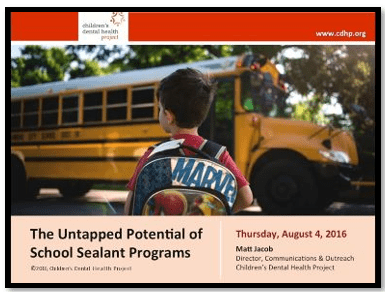
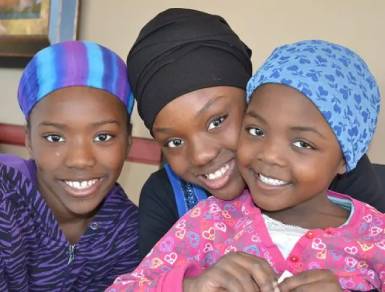
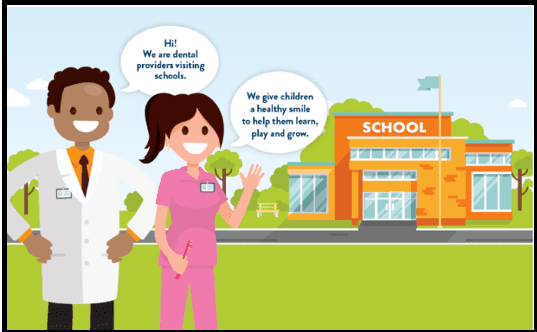
School-Based Dental Sealant Programs: Recommendations.
Children’s Dental Health Project; April 11, 2017
View HERE
School-Based Dental Sealant Programs: Second Edition
National Maternal & Child Oral Health Resource Center
A series of modules designed to ensure that school-based dental sealant program staff have a thorough understanding of the history, operations, and underlying principles of this care delivery model.
View HERE
Seal America: The Prevention Invention
National Maternal & Child Oral Health Resource Center
A stepwise approach for planning and implementing school-based dental sealant programs.
View HERE
Head Start Dental Hygienist Liaison Project
A Guide to the Periodicity Schedule and Oral Exam
Learn about volunteer opportunities to provide oral health education for Head Start-enrolled children and their families.
Because of the importance of oral health during pregnancy and early childhood, in 2011 the National Center on Health, working in partnership with the American Dental Hygienists' Association (ADHA), created the Dental Hygienist Liaison (DHL) project. Under the DHL project, one dental hygienist from each state volunteers to help promote oral health for pregnant women and children enrolled in Head Start.
https://www.astdd.org/head-start-state-dental-hygienist-liaisons-information
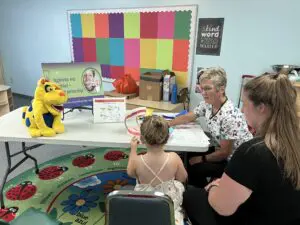
Cathy Jo Gunvalson, Licensed Dental Hygienist, Minnesota's DHL
Special Care Dentistry/Special Populations
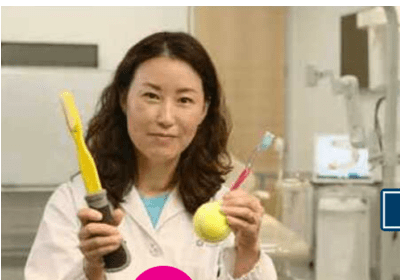
Photo credit: Special Olympics:
How to Dental Videos; Adapt a Toothbrush
Special Care: An Oral Health Professional’s Guide to
Serving Children with Special Health Care Needs.
Second Edition
Series of five modules View HERE
Oral Health Education in the Classroom
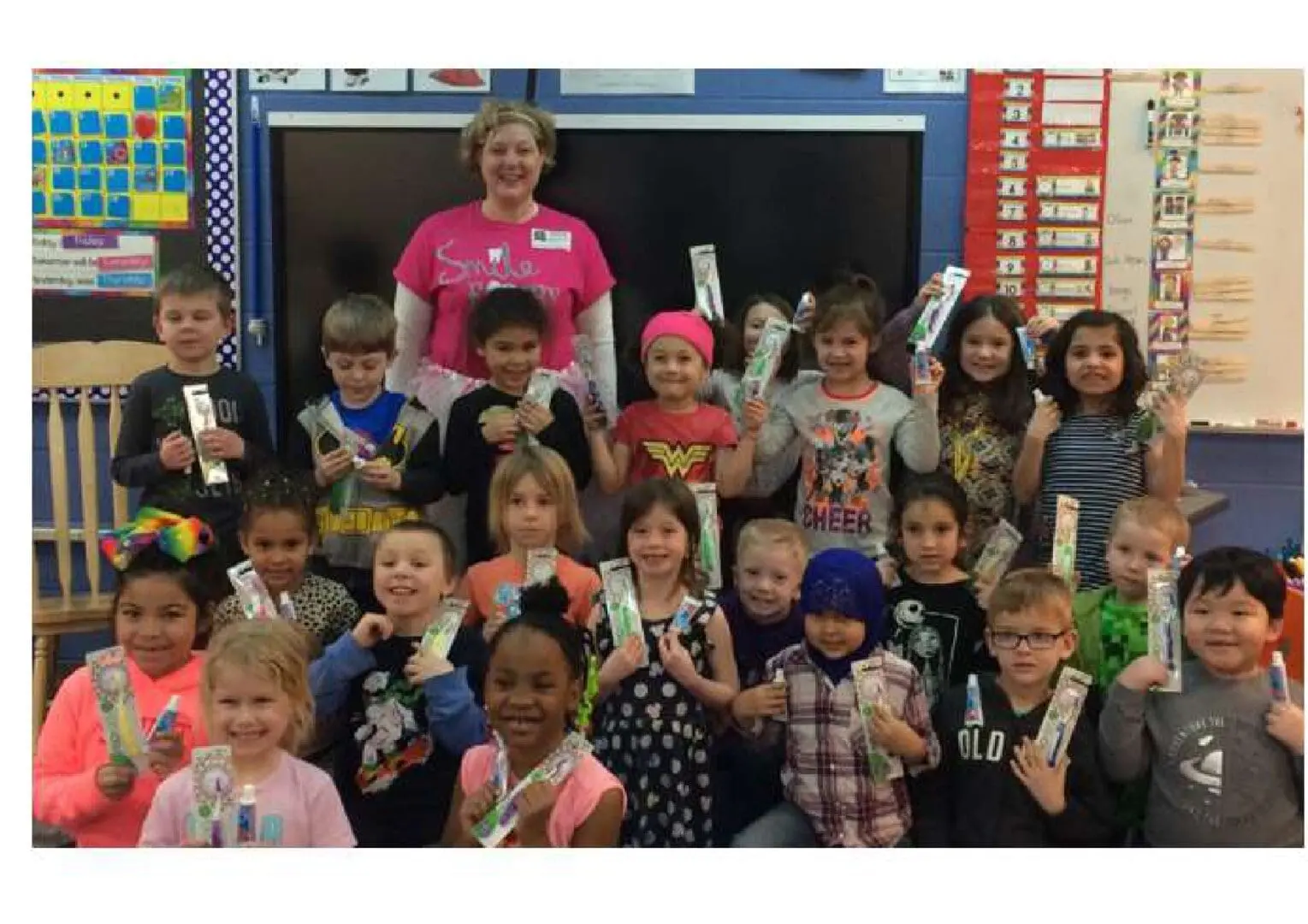 Photo used with permission: Let’s Smile, Inc., Owatonna, MN
Photo used with permission: Let’s Smile, Inc., Owatonna, MN
NOTE: Although oral health education is an integral part of the care provided by collaborative practice dental hygienists, a collaborative agreement is not required to provide oral health education in schools, community events or public health settings.


Older Adult/Geriatric/Long-Term Care
Growing Old with a Smile: Oral Health for Older Adults in Long-term Care.
Video Series. Minnesota Dental Association website.
View HERE
Dental Equipment/Delivery Options
to facilitate
Collaborative Dental Hygiene Practice in Community Settings
Portable Equipment Delivery: Elementary School
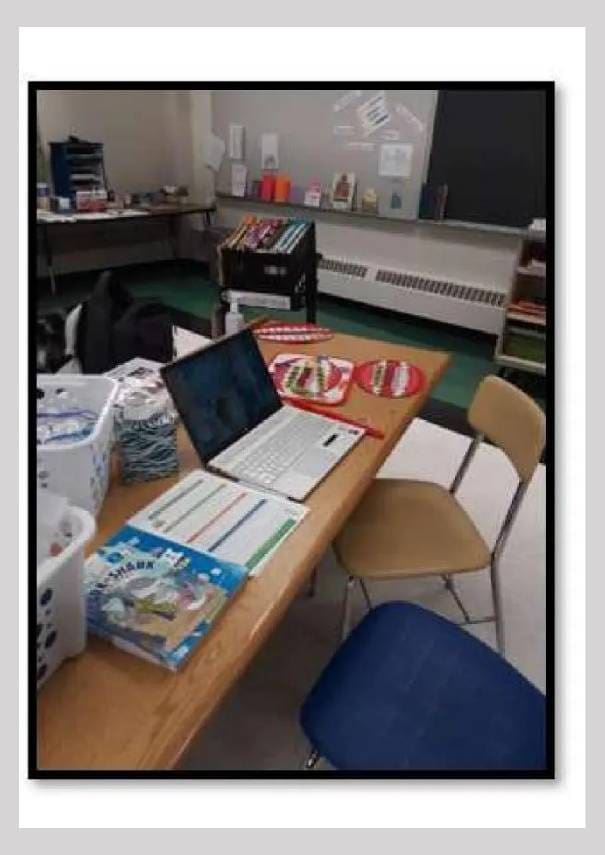
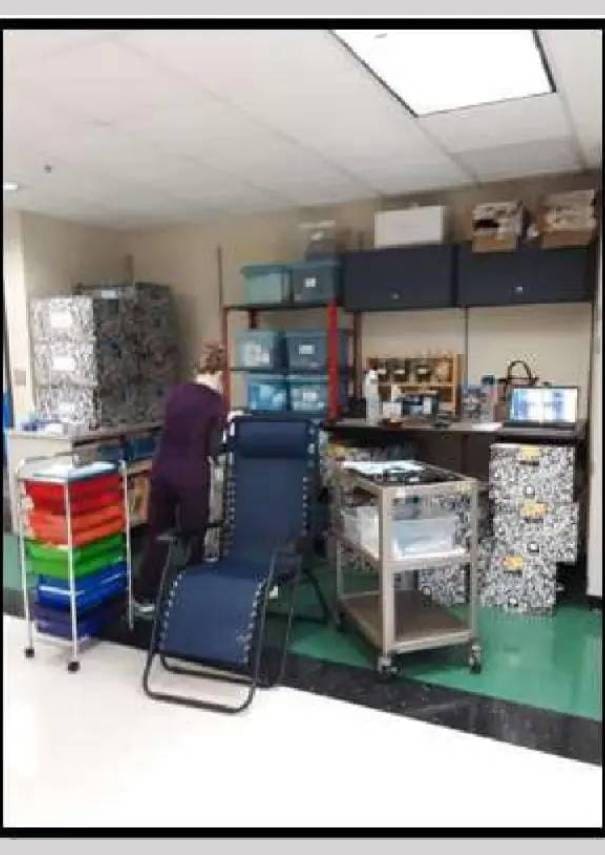
Mobile Equipment Delivery to Facilities/Schools/Community Sites

Photo used with permission: Apple Tree Dental, Mounds View, MN
Stationary Dental Clinic: Long-Term Care Facility

Tele-dentistry/Telehealth
Tele-dentistry has been implemented and expanded to help reduce patients’ barriers to care; improve program and dental team efficiency; respond to the Covid-19 pandemic.
“In a traditional dental office visit, a dental hygienist, therapist or assistant typically collects and documents the patient’s oral and overall health status for interpretation by a dentist or advanced dental therapist. This is very similar for tele-dentistry, however patient information captured by the on-site dental team is reviewed by the remote dentist in either synchronous (real-time) or asynchronous (store and forward) modality.”
Source: Apple Tree Dental: Tele-dentistry From 2002 to 2020. ASTDD Descriptive Activity Report. Association of State and Territorial Dental Directors (ASTDD).
View HERE
Tele-Dentistry: Is it Right For Our Office Today and In The Future?
Angela Hastings, DMD
View HERE
Financial Side of Collaborative Dental Hygiene Practice
As with any new endeavor, a strong financial/business plan must be explored/created to assure sustainability into the future. Decisions must be made whether to seek grants and/or funding from charitable foundations, to learn what is involved with billing for services provided to Minnesota Public Health Program enrollees, or whether you need to connect with managed care organizations. It is likely that some of your personal capital will be part of the financial equation as you enter into a non-traditional endeavor. The following two presentations will be a great resource for you.
Starting a Non-Profit: 101 Nancy Franke Wilson; Minnesota Oral Health Coalition; (29.03)
View HERE
Grant Basics: 101 Nancy Franke Wilson; Minnesota Oral Health Coalition; (1:02:18)
View HERE
Billing and reimbursement for services rendered by a collaborative practice dental hygienist when providing services to Minnesota Health Care Program (Medicaid or MinnesotaCare) enrollees?
Collaborative Practice Dental Hygienists
Revised: February 18, 2020
View HERE
Overview
Collaborative practice dental hygienists must be employed or retained by one of the following Minnesota Health Care Programs (MHCP)-enrolled groups:
- Health care facility
- Program (such as Head Start)
- Nonprofit organization
Individual collaborative practice dental hygienists are not eligible for direct MHCP reimbursement.
Individual collaborative practice dental hygienists must enroll with a group affiliation to receive reimbursement at the group level for all dental hygiene services rendered to MHCP enrollees. As part of this process, MHCP requires individual National Provider Identifiers (NPIs) and affiliation with one or more of these enrolled group providers.
- Individual dental hygienists must indicate their group affiliations on their applications.
- Enrolled groups must add their enrolled collaborative practice dental hygienists to their provider file using the Organization MHCP Provider Profile Change Form (DHS-3535A) (PDF).
- Groups not yet enrolled must include individual group members, including collaborative practice dental hygienists.
For collaborative practice dental hygienists providing services to enrollees in a managed care organization (MCO), contact the MCO* for enrollment requirements and coverage.
Covered Services
MHCP reimburses for covered dental services within the scope of practice of the collaborative practice dental hygienist as identified in Minnesota Statutes, 150A.10, subdivision 1a.
Billing
Bill all services completed in a collaborative practice capacity using the following:
- 837D format
- Individual collaborative practice dental hygienist NPI as the rendering provider
- Appropriate health care facility program (such as Head Start), or nonprofit NPI as the pay-to provider (provider who receives the payment)
Additional Resources
Minnesota Statutes, 150A.10, subdivision 1a (collaborative practice authorization for dental hygienists in community settings)
*MCO contacts for MHCP providers
Minnesota Health Care Programs (MHCP) providers can contact the managed care organizations (MCOs) using the phone and fax numbers listed for each MCO. Refer members to health plan member services phone numbers.
Resources, Publications, Reports
Advancing Dental Hygiene Education: What does research tell
us about the future of dental hygiene?
“Minnesota has a reputation for developing and implementing innovative and creative ways
to meet the demands of a prepared and competent dental workforce.”
Colleen M. Brickle, RDH EdD
Journal of Dental Hygiene: October 2018
View HERE
The Journey to Opportunity
"Dental hygienists who embrace change, reflect on their professional status and goals, and unite
with colleagues are poised for professional growth."
Debra J. Sidd, RDH, RF, MEd
Dimensions of Dental Hygiene: Apr 17, 2017
View HERE
Paving the Way To Achieve Health Equity and Access to Oral Health Care Through Integration of an Inter and Intraprofessional Workforce
Minnesota State Oral Health Plan 2030
View HERE
Collaborative Practice as a Strategy for Increasing Access to Oral Health Care in Minnesota
The Network for Public Health Law: Issue Brief
View HERE
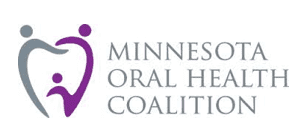
Minnesota Oral Health Coalition (MOHC) Homepage
https://www.minnesotaoralhealthcoalition.org/
MOHC YouTube Channel * Infomars (webinars)" and conference presentations)
View HERE
MOHC “Infomar” hand-outs and relative information
View HERE
